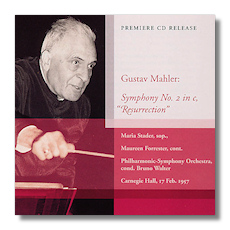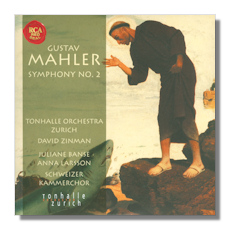
The Internet's Premier Classical Music Source
Related Links
- Mahler Reviews
- Latest Reviews
- More Reviews
-
By Composer
-
Collections
DVD & Blu-ray
Books
Concert Reviews
Articles/Interviews
Software
Audio
Search Amazon
Recommended Links
Site News
 CD Review
CD Review
Gustav Mahler

Symphony #2 in C minor "Resurrection"
Maria Stader, soprano
Maureen Forrester, contralto
"Philharmonic-Symphony Orchestra"/Bruno Walter
Music & Arts CD-1199 ADD monaural 79:47


Juliane Banse, soprano
Anna Larsson, contralto
Schweizer Kammerchor
Tonhalle Orchestra Zürich/David Zinman
RCA Red Seal 82876-87157-2 Hybrid Multichannel SACD 2CDs: 22:04, 58:42
I spent the weekend with Mahler's mighty "Resurrection" Symphony and lived to write about it! (I am still waiting for my t-shirt.)
Bruno Walter made a studio recording of this imposing work with the New York Philharmonic. It took him a while to do it, however, because he suffered a heart attack in March 1957 after recording the fourth and fifth movements – the first to be scheduled. He completed the work almost one year later, and the finished recording, originally issued on the Columbia label, is remarkably consistent, all things considered.
Compared to the feverish interpretations of Bernstein, Solti, and the like, Walter's Mahler Second is pretty level-headed. The studio recording disappoints some listeners, particularly those who were weaned on the aforementioned conductors. The trick with this symphony, I think, is to create a sense of occasion without playing to the galleries, or lapsing into bombast, histrionics, or hysteria. If a vertical line describes an "ideal" Mahler Second (as if there were such a thing!) Bernstein and Solti would be to the left of it, and Walter's studio Mahler Second would be equidistant from it, but to the right.
I think this live recording would be closer to the center. It was recorded on February 17, 1957 in Carnegie Hall. This was a special occasion: Walter had announced that he would not be returning as the orchestra's Guest Conductor, and this was his last concert in that capacity. The "Resurrection" was an apt choice. Walter had programmed it with the Philharmonic twice before (in 1942 and 1948), but this was the first time that he and the orchestra performed it together in German.
According to Music & Arts, this is the first appearance of this live Walter "Resurrection" on CD. I find this astonishing, because this is both a very important and a very well recorded performance. The timings are almost identical to those on the studio recording, but I think the live recording has a great deal more impact. That elusive sense of occasion is present, and Walter seems more willing to realize the symphony's drama, particularly in the opening movement. (Did he hold back in the studio, aware of the damage that his heart had suffered?) Again, this is not a "wow" performance, but the missing animal excitement is balanced by the conductor's integrity, and toughness of approach. There's also serenity here, perhaps because Walter was 80 years old, and close enough to death to know that resurrection would be a fulfilled promise and not a calamitous event.
Music & Arts doesn't identify the choir, but it is the Westminster Choir, who also participated in the studio recording. Soprano Maria Stader is superior to Emilia Cundari, who sings in the studio version. (Stader was under contract to a different label, and therefore was unavailable for the recording.) Forrester is rock-solid, womanly but not maternal, on both recordings. There are fewer mishaps than one would expect from a live recording, although near the end of the work, Stader enters early on one occasion. She covers nicely. The important brass are clear and present – more impressive than on the studio recording, actually. There is virtually no distortion, the dynamic range is impressive, and balances (within the orchestra; and between the orchestra, the chorus, and the soloists) are excellent. A long essay by Mark W. Kluge adds to the attractions of this Music & Arts release. Even if you have the studio version, you need to hear the present version.
Zinman's "Resurrection" is the second release in what I hope will be a complete Mahler series for this conductor with Zürich's Tonhalle Orchestra. (Mahler's First Symphony is on RCA Red Seal 82876 87156 2.) His Beethoven, Schumann, and Richard Strauss discs for Arte Nova have been a resounding success. The appearance of these Mahler discs on a full-priced label suggests that Sony-BMG Masterworks appreciates their potential to be the definitive Mahler recordings of the current decade.
Credit has to be given where credit is due. While the Tonhalle Orchestra doesn't possess the sleek and streamlined glory that characterizes (for example) the major orchestras in Chicago and Philadelphia, it is one of the few international-class orchestras in action today that retains an Old World sound and a distinctive personality. They seem to be frozen in time, and believe me, in today's orchestral world, that is mostly a good thing.
Zinman was a pupil of Pierre Monteux, who was not particularly known as a Mahler conductor, but that doesn't matter. Zinman's approach to this score is closer to Walter's than Bernstein's. There is not a lot of "showmanship"; the heart is there, but it is not worn on the conductor's sleeve. The biggest difference between Zinman and Walter, however, is that Zinman pays more attention to the score's details, and not as much to its overall structure. The result is a performance that is more impressive from one moment to the next, but that leaves the listener a little less satisfied once it is all over. Although the last movement is a little bit of a let-down, overall, this is less a complaint than an observation. Zinman is a very good conductor, and I would rather hear him conduct this work than many other conductors who quickly come to mind.
Zinman's tempos are not dramatically different from Walter's, except in the fourth movement, "Urlicht," which is a whole minute slower. (Zinman is more tender here, but Walter, with his core of strength, is more comforting.) The slower tempos push Zinman's recording onto a second disc. Sensibly, the first movement is by itself on the first SACD, and the rest are on the second, thereby encouraging listeners to respect the "long pause" that Mahler requested.
Larsson is not as moving as Forrester in "Urlicht" (I think Zinman's tempos get in the way a little here), and Banse is not as radiant as Stader in the last movement. The Swiss Chamber Choir has been well-drilled for this recording; if they had been placed a little farther forward, they would have made a greater impact.
The engineering is truthful, adding no spectacle to what already had been put into place by Mahler and Zinman. The offstage band in the last movement is nicely captured.
I'd be very willing to live with either of these "Resurrections." I am glad, however, that I don't need to choose between them, any more than I have to discard favorite recordings by Klemperer and (when I am in that certain mood) Bernstein.
Copyright © 2007, Raymond Tuttle




















